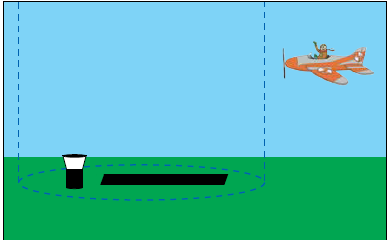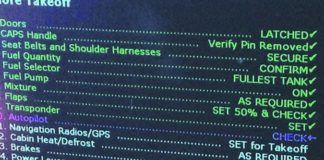The first thing that happened was a sudden shift in “safety” concerns over to handling COVID- 19. Should I go fly? Wear a mask? But, where we began and where we’re headed now are two very different paradigms. The aviation safety culture we’ve built over decades is somewhat perishable—it’s not just like “riding a bike”—and it’s dynamic in that some things have to change and adapt to new realities for the overall safety focus to remain viable.
Initial Impact
Back in the January/February time frame, the NAS was hopping. Airlines to flight training were all moving with a purpose in an often near-full system. Then COVID-19 nearly shut it all down.
What started out as a “knee jerk” reaction slowly turned into a cautious “logical” one as information became available. The FAA started to realize the impact and almost immediately sent home all non-essential workers. Some facilities closed due to positive COVID-19 tests. Other facilities soon followed with reducing staffing. All over the country, seven or eight-person days were down to four or even less.
Meanwhile, a good portion of NAS customers stopped flying. For ATC, fewer customers require less staffing. While the airlines will take a lot longer to recover, some flight schools took the “14-day quarantine” literally and returned to the airport on day 15 ready to go full speed.
Basically, how the FAA reacted didn’t exactly line up with how pilots reacted. The virus hit; less staffing is required to handle reduced flying. Then, 14 days later, there’s still less staffing and some f lying resumes, mainly in the flight schools. For example, what was 900 operations per day went down to around 100. Then after 14 days the flight schools returned and it suddenly went back up to 400 or more and kept rising. So, those locales hadn’t returned to full force, but did require an increased staffing over the lowest level. Not all facilities got that.
During a normal workday, few controllers work alone. There is generally a supervisor and/or a couple other controllers who can relieve someone. In the wake of COVID-19, there might have only been one controller available for relief. I worked a couple 150-plus ops-per-hour rounds by myself—I was Tower, Ground, Clearance, Flight Data, and oh yeah, I was also the Controller in Charge (CIC). Now ability aside, this is normally a two-person, or maybe even three-person function even on slow days. Immediately, at facilities like mine, staffing-based services such as line up and wait, saturated patterns (five to seven at once), practice approaches, and others all went away. On certain days at peak times, you were lucky to land at all.
Reduced Services
As noted, most controllers manage workload by trimming what they can do. Contrary to popular belief, the ability and decision to continue offering workload-permitting services is given to the controller working the traffic; it is not explicitly limited by the FAA. Of course, an option for pilots who might not get what they wanted at a towered field is to practice at nontowered fields.
So, with minimal staffing, especially at larger facilities, services can be curtailed, and those remaining can incur delays. But some controllers use the increased per-person workload as a way to keep their skills sharp. Of course, this can backfire and end up with even more reduced services if the workload gets dangerously high. Hopefully the transition back to normal staffing and normal hours will continue. Like pilots, controllers get rusty with unused skills, so some of us will have a little rust to knock off as things do return to more-or-less normal.
Controllers at certain facilities have access to simulators, just like pilots do. Centers and most Approach controls
have radars that can be used real time and in scenario-based training. Towers on the other hand might or might not have a simulator at their disposal. Wait. We’re talking about controllers going into the sim to get practice? Unless a controller is in training or working on creating those training scenarios, simple practice is rare. Controllers do have recurrent training every six months, but it is not scenario-based training. It’s more like a refresher on existing rules and maybe some newer ones.
Pilot Trends
Who was still flying during the worst of the COVID-19 restrictions? Certainly, not many professional pilots were flying because there were so few passengers. Most serious owner/pilots who use their aircraft for business had no place to go. That left a higher percentage of lesser experienced pilots than we’re used to seeing. Of course, this is a broad, perhaps unfair, generalization.
I noticed a definite shift in capabilities away from polished technique, with a degradation of radio-communication skills (one of my pet peeves), forgetting (or ignorance of) various airspace boundaries and restrictions, and a general decrease in the average demonstrated skills. These were the trends during the height of the restrictions. Now that things are loosening, I’m seeing fewer of these bad habits, but they still seem to occur, just as they always did.
Why? Well, as noted, I think the general experience level of pilots flying decreased as pros and other hightime pilots were idled. But, even with that I think that the overall decrease in flying contributed to a lot of pilots getting stale. It happens to all of us— develop a skill that requires constant use and stop using it and we get rusty. It’s natural.
b. Pilots of airborne aircraft should read back those parts of ATC clearances and instructions containing altitude assignments, vectors, or runway assignments as a means of mutual verification. The read back of the “numbers” serves as a double check between pilots and controllers and reduces the kinds of communications errors that occur when a number is either “misheard” or is incorrect.
1. Include the aircraft identification in all readbacks and acknowledgments. This aids controllers in determining that the correct aircraft received the clearance or instruction. The requirement to include aircraft identification in all readbacks and acknowledgements becomes more important as frequency congestion increases and when aircraft with similar call signs are on the same frequency.
EXAMPLE−
“Climbing to Flight Level three three zero, United Twelve” or “November Five Charlie Tango, roger, cleared to land runway nine left.”
2. Read back altitudes, altitude restrictions, and vectors in the same sequence as they are given in the clearance or instruction.
3. Altitudes contained in charted procedures, such as DPs, instrument approaches, etc., should not be read back unless they are specifically stated by the controller.
4. Initial read back of a taxi, departure or landing clearance should include the runway assignment, including left, right, center, etc. if applicable.
If a pilot recognizes that he or she is rusty, it’s a lot easier to handle than someone who thinks he’s still at the top of his game, but isn’t. This creates a hazardous environment for not only themselves, but for everyone in the airspace. If I identify someone who’s truly rusty—which is often easy from their lack of radio confidence and decisiveness— I help them and give them as much room as practical. But, if I’m busy with other traffic and we’re at reduced staffing, I might not be able to offer as much assistance as they might find useful.
Interestingly, I encountered a good deal more aircraft entering Class D airspace without permission. (See §91.129) It was clear that most of the culprits were under the impression that the Tower had completely closed. The frequency of this followed the rate of new COVID-19 infections; it jumped up to a high and is slowly on its way back down.
There’s one last trait in some pilots that most controllers struggle with— not reading back ATC instructions.
Before COVID-19 and especially once the restrictions were in place, we’ve been seeing more wrong-surface landings. Clearly this starts with expectation bias—or simply confusion that’s never resolved—but I believe that one of the main causes is not reading back ATC instructions. Of course, this isn’t just isolated to landing and runway assignments; we see it in most types of clearances and instructions.
A careful observer on the radio will note that domestic pilots who are most comfortable on the radio will often reduce the instruction to just the salient numbers or points, rather than repeating the entire clearance verbatim. However, foreign pilots, usually not native English speakers, will commonly parrot everything the controller says. Either is acceptable and verifies to everyone on frequency that the pilot and the controller are on the same page. Not reading back instructions leaves some room for doubt and diligent controllers and pilots will watch that pilot more carefully.
It is interesting to note that the regulations don’t always explicitly require readbacks unless requested. So, in many cases, you could argue that a simple, “WilCo” works. But, then there’s AIM 4-4-7.b. that does advise us to read back controller instructions.
By now, we should all know that runway and hold-short instructions must be read back; “WilCo” is insufficient. Unfortunately, however, not all pilots have yet gotten the message. While this is a requirement on you, it’s also a requirement on me; I’m required to hear a readback of runway assignments and hold-short instructions. I spend considerable effort each day coaxing some reluctant pilots to read back these instructions. Sometimes, I even need to try to put the words into the pilot’s mouth: “I need to hear you say the words, ‘Hold short Runway 28.’”
Getting Back In the Saddle
It’s too soon to tell if we’ll see ongoing effects from the virus. We’re still recovering from fewer airplanes, fewer controllers, and even possibly reduced funding. Jumping back in the saddle and thinking we’re all ready to go as if everything is back to normal is the last thing we should be doing. We all need to be aware of the changes and ongoing impact, plus the possibility of our own need to knock off some rust. Of course, procedures and operations within the National Airspace System (NAS) are continually evolving to meet current needs. Returning to pre-COVID-19 efficiency and safety will not happen overnight. Over time, things will surely stabilize and we will learn to adapt to whatever new realities emerge. Hopefully, NAS will emerge improved from what it was.





